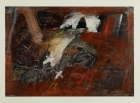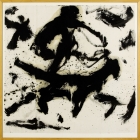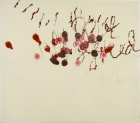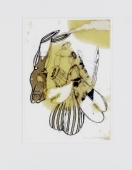
Artist | Jean-Frédéric Schnyder (*1945)
https://www.artist-info.com/artist/Jean-Frederic-Schnyder
 Artist Portfolio Catalog
Artist Portfolio Catalog
| Image | Artist | Title | Year | Material | Measurement | ||||||||||||||||||||
|---|---|---|---|---|---|---|---|---|---|---|---|---|---|---|---|---|---|---|---|---|---|---|---|---|---|
 |
Jean-Frédéric Schnyder | Bergfrühling | 1987 | oil on canvas | 200 x 160 cm | ||||||||||||||||||||

Jean-Frédéric Schnyder (*1945)Bergfrühling
|
|||||||||||||||||||||||||
 |
Jean-Frédéric Schnyder | Studie | 1984 | oil on canvas | 21 x 30 cm | ||||||||||||||||||||

Jean-Frédéric Schnyder (*1945)Studie
|
|||||||||||||||||||||||||
Biography
Biography
born in 1945
About the work (english / deutsch)
About the work (english / deutsch)
The Charisma of Jean-Frédéric Schnyder
Since the early 80s, Jean-Frédéric Schnyder has confronted us with a paradox. As though a sudden revelation had issued from his widely varied work, he draws together, as his point of departure, a spectrum of compositional worlds spanningfolk art, kitsch, traditional landscape painting and categories from the fields of surrealism, constructivism, abstract or realist painting, even the fairytale world of book illustration. For Jean-Frédéric Schnyder, these are highly communicative visual languages.
Between 1970 and 1980, often in extreme isolation, he worked inexorably and intuitively towards the point of dedicating himself to painting. This is not to say that the works he created during this period should be regarded as preliminary studies. Rather, they represent the different strands which converged at a certain moment in which painting revealed itself as a compositional category. Finding the innovative style of the former avantgarde an inadequate vehicle for the fulfilment of his holistic aims, Jean-Frédéric Schnyder called for a radically open approach. In contrast to the avantgarde tendency of exclusion rather than inclusion, he set about breaking down barriers. His stance being more charismatic than theoretical, what resulted was a programmatic approach, the existential effects of which he could hardly have foreseen himself.
From here on, all these divergent compositional worlds had to be infused with life. In other words, although Jean-Frédéc Schnyder uses a visual language and patterns of perception specific to each of the compositional categories, he nevertheless transforms them from within, in the form of an act of faith. It is a feat which hardly bears contemplation: how, after all, is it possible to sustain the constant flux of maximum dispersion, as opposed to the bundled energy of direct impact?
I believe this can be achieved only by means of a holistic global view - holistic in the sense of dissolving categories and breaking down borders with homeopathic intensity a) by presenting them as being of equal value, b) by re-creating them from one’s own point of view.
The viewer, taken unawares, may be forgiven for talking of „quotations" or even for equating individual images with the respektive pictorial categories - for example by identifying a painting which looks kitschy with kitsch. This is hardly surprising, given the fact that there are paintings in which the subtle difference is discernible only within a wider context. On closer examination, however, the sheer devotion invested in the act of painting is evident in most of the works displayed.
In addition to the visual language and patterns of perception of compositional categories re-defined from within, there is also the existential moment dictated by external conditions. The static „introspection“ achieved at a sheltered workplace is contrasted with a dynamic force which, instead of simulating the turbulence of emergent form, actually strains it by exposure, thereby generating authentic effects. This is, admittedly, a construct. Yet it is a construct - like some form of 19th century plein-air painting taken to the extreme which actually involves direct experience and endurance. It is at this point that everything becomes simultaneously absurd and/or meaningful.
Jean-Frédéric Schnyder is, I believe, singularly aware of this point. I shall therefore take one painting by way of example to illustrate the way he integrates life, as a conscious act, into art. The painting, oil on canvas, entitled Gebet (Prayer), executed in 1988, measures 150 cm high by 200 cm wide. The rectangular format is reiterated in the centre of the painting by a rectangular pale blue area (sky) in which four schematic tulips can be seen in a row; the stems and leaves of the flowers are green, their petals are yellow, orange, red and violet. The rest of the painting is dominated by a small-scale grid of black and white squares. While the colours of the sky and the flowers (nature) embrace the colour wheel, the rest of the painting is in the non-colours black and white. The grid-like structure (abstraction) can be seen as a method of achieving the greatest possible regular dispersion of non-colours. Jean-Frédéric Schnyder commences the handwritten prayer, the Lord’s Prayer, at the top right. In four continuously spiralling forms, he unfurls the uninterrupted text right through to the final Amen, ending on the right above the pale blue rectangular area. The lettering is in a pale flesh tone. It is the colour incarnate which, according to the artist, is not included in the colour wheel.
The painting of the prayer corresponds in a way to the painting of the image: the image is created through the duration of the prayer. The painting of the image, an act of concentration over a period of weeks, occurs in the form of a prayer. Prayer is concentrated attention. A prayer may not exceed a certain length, as concentration would otherwise begin to flag. It must be simple, as everyone must be able to understand the words and the content. The same applies to sentence structure and rhythm. In this respect, Gebet (Prayer) by Jean-Frédéric Schnyder reflects the simplicity of composition and representation as well as the process of painting.
German text by Jean-Christophe Ammann / Translation by Ishbel Flett
(Extract - Full printed version available in the Museum)
MMK - Museum für Moderne Kunst, Frankfurt am Main
Das Charisma des Jean-Frédéric Schnyder
Seit den frühen 80er Jahren konfrontiert uns Jean-Frédéric Schnyder mit einem Paradox. Wie aus einer jähen Erkenntnis heraus, die eine Folge seines vielfältigen Schaffens ist, vereint er, im Sinne einer Ausgangssituation, einen ganzen Katalog bildnerischer Welten. Es handelt sich hierbei um Kategorien der Volkskunst, des Kitsches, der traditionellen Landschaftsmalerei, um Kategorien, die dem Surrealismus, der konstruktiven, der abstrakten oder der realistischen Malerei zuzuordnen sind, bis hin zur Märchenwelt im Bereich der Buchillustration. Für Jean-Frédéric Schnyder sind es Bildsprachen, die einen hohen kommunikativen Stellenwert besitzen.
In den Jahren 1970-1980 hat er hartnäckig und oft in größter Abgeschiedenheit intuitiv auf den Schritt, sich der Malerei zuzuwenden, hingearbeitet. Das heißt jedoch nicht, daß die Werke, die in diesem Jahrzehnt entstanden sind, etwa als Vorarbeiten zu verstehen wären. Vielmehr waren es verschiedene Stränge, die in einem bestimmten Moment zusammenliefen, als sich die Malerei selbst als eine bildnerische Kategorie herausstellte. Da der Totalitätsanspruch über den innovativen Stil der einstigen Avantgarde nicht einzulösen war, plädierte Jean-Frédéric Schnyder für eine radikale Öffnung. Im Unterschied zu den Avantgarden, die mehr aus- denn einschlossen, baute er jegliche Grenzen ab. Da es sich weniger um eine theoretische, sondern eher um eine charismatische Position handelte, entwickelte sich daraus eine Programmatik, deren existentielle Auswirkungen er wohl selbst kaum abzuschätzen wußte.
Fortan ging es darum, alle diese verschiedenen Bildwelten mit Leben, mit dem eigenen Leben zu erfüllen. Das heißt: Jean-Frédéric Schnyder verwendet zwar bildsprachliche Elemente und Wahrnehmungsmuster der je spezifischen bildnerischen Kategorien, aber er verwandelt sie von innen heraus in Form eines Glaubensaktes. Das ist in der Tat schier nicht vorstellbar, denn, so fragt man sich, wie ist es möglich - im Unterschied zur gebündelten Energie einer Stoßachse -, eine maximale , Streuung gleichermaßen „unter Strom“ zu halten. Ich glaube, daß dies nur kraft einer Gesamtsicht von Welt zu erreichen ist. Gesamtsicht heißt, durch homöopathische Intensität die Auflösung der Kategorien bzw. deren Grenzen zu bewirken, a) indem ich sie als gleichwertig existenzberechtigt darstelle, b) indem ich sie aus eigener Sicht neu schaffe. Der unvorbereitete Besucher wird leicht von Zitaten sprechen, ja, er wird sogar einzelne Bilder mit der jeweiligen Bildkategorie gleichsetzen, beispielsweise ein kitschig aussehendes Bild mit Kitsch identifizieren. Das kann ihm nicht einmal übelgenommen werden, weil es Bilder gibt, in denen die minimale Differenz nur aus einem größeren Zusammenhang zu erkennen ist. Jedoch wird in den allermeisten Bildern beim genauen Hinschauen die buchstäbliche Hingabe durch den malerischen Akt ersichtlich.
Dieser Akt der Entäußerung entfernt sich keineswegs vom ursprünglichen Konzept, im Gegenteil! Zusätzlich zu den bildsprachlichen Elementen und Wahrnehmungsmustern bildnerischer Kategorien, die von innen heraus neu definiert werden, tritt das durch äußere Bedingungen diktierte existentielle Moment. Der Statik der „lntrospektion“ am geschätzten Arbeitsplatz steht eine Dynamik gegenüber, welche die Turbulenzen der Formwerdungen nicht etwa simuliert, sondern durch ein Ausgesetztsein mit realen Auswirkungen strapaziert. Natürlich handelt es sich hier um eine Konstruktion. Aber diese Konstruktion - eine Art Plein-Air-Malerei des 19. Jahrhunderts ins Extrem gesteigert - ist unmittelbares Erleben und Erleiden. An diesem Punkt wird alles absurd und/oder sinnvoll zugleich. Ich glaube, daß Jean-Frédéric Schnyder sich über diesen Punkt sehr genau im klaren ist und möchte deshalb an einem einzelnen Bild aufzeigen, wie er das Leben als bewußten Akt in die Kunst integriert. Das Bild, Öl auf Leinwand, trägt den Titel Gebet, ist 1988 entstanden, mißt 150 cm in der Höhe und 200 cm in der Breite. Dem rechteckigen Format entspricht im Zentrum des Bildes ein rechteckiges hellblaues Feld (Himmel), in dem, nebeneinandergereiht, vier schematisch dargestellte Tulpen zu sehen sind; Stil und Blätter der Blumen sind grün, die Farben der Blüten sind gelb, orange, rot und violett. Die gesamte Restfläche des Bildes wird durch ein kleinteiliges Rasterfeld von schwarzen und weißen Quadraten bestimmt.
Die Farbgebung von Himmel und Blumen (Natur) enthält den Farbtonkreis, die Restfläche die Nichtfarben Schwarz und Weiß. Die Rasterstruktur (Abstraktion) erklärt sich als Methode, eine größtmögliche regelmäßige Streuung der Nichtfarben zu erreichen. Mit dem handschriftlich gemalten Gebet, dem “Vaterunser“, setzt nun Jean-Frédéric Schnyder rechts oben ein. In vier spiralförmigen, flächendeckenden Umgängen entwickelt er den bruchlos geschriebenen Text bis zu dem Amen, das rechts über dem hellblauen Rechteckfeld das Gebet beendet. Die Schriftfarbe besteht aus einem hellen Rosa. Es ist die Farbe des Inkarnats, die, so der Künstler, im Farbtonkreis nicht enthalten ist.
Dem Malen des Gebets entspricht gewissermaßen das Malen des Bildes: Über die Dauer des Gebets entsteht das Bild. Das Malen des Bildes, als ein über viele Wochen andauernder Akt der Konzentration, geschieht in Form eines Gebetes. Das Gebet ist konzentrierte Hinwendung. Ein Gebet darf eine gewisse Länge nicht überschreiten, weil sonst die Konzentration nachläßt. Es muß einfach sein, denn jeder muß die Worte und den Inhalt denken können. Dies betrifft ebenso die Satzstruktur und den Rhythmus. Insofern reflektiert das Gebet von Jean-Frédéric Schnyder sowohl die Einfachheit von Komposition und bildnerischer Darstellung als auch den Prozeß der Malerei.
Text von Jean-Christophe Ammann
(Auszug - Der vollständige Text ist als Informationsblatt beim Museum erhältlich)
MMK - Museum für Moderne Kunst, Frankfurt am Main
 Exhibition Announcements Exhibition Announcements 
| Learn more about this service |
|---|
 offers / Requests offers / Requests  |
Learn more about this service |
|---|
 Visualization |
Learn more about this service | ||
|---|---|---|---|

Interested in discovering more of this artist's networks?
3 easy steps: Register, buy a package for a visualization, select the artist.
See examples how visualization looks like for an artist, a curator, or an exhibition place: Gallery, museum, non-profit place, or collector.

Exhibition History

|
SUMMARY based on artist-info records. More details and Visualizing Art Networks on demand. Venue types: Gallery / Museum / Non-Profit / Collector |
||||||||||||
| Exhibitions in artist-info | 45 (S 16/ G 29) |
Did show together with - Top 5 of 499 artists (no. of shows) - all shows - Top 100
|
||||||||||
| Exhibitions by type | 45: 7 / 20 / 18 / 0 | |||||||||||
| Venues by type | 31: 7 / 9 / 15 / 0 | |||||||||||
| Curators | 20 | |||||||||||
| artist-info records | Jul 1968 - Apr 2015 | |||||||||||
|
Countries - Top 5 of 6 Switzerland (18) Germany (13) United States (2) United Kingdom (2) Italy (1) |
Cities - Top 5 of 20 Zürich (9) Frankfurt am Main (6) Bern (6) Luzern (4) Basel (3) |
Venues (no. of shows )
Top 5 of 31
|
||||||||||
Curators (no. of shows)
Top 5 of 20
|
| Kunsthaus Zürich | G | Sep 2014 - Apr 2015 | Zürich | (665) | +1 | |
| Kunstmuseum Luzern | G | Feb 2013 - Jul 2013 | Luzern | (521) | +1 | |
| Lichtin, Christoph (Curator) | +1 | |||||
| Kunstmuseum Bonn | G | Jun 2011 - Sep 2011 | Bonn | (181) | +1 | |
| Berg, Stephan (Curator) | +0 | |||||
| Gronert, Stefan (Curator) | +0 | |||||
| Hard Hat | S | May 2009 - Jun 2009 | Genève | (38) | +0 | |
| Migros Museum für Gegenwartskunst - Zürich | G | May 2008 - Aug 2008 | Zürich | (121) | +0 | |
| Munder, Heike (Curator) | +0 | |||||
| Schinwald, Markus (Curator) | +0 | |||||
| Museum für Gegenwartskunst Basel | S | Apr 2007 - Aug 2007 | Basel | (86) | +0 | |
| Kaiser, Philipp (Curator) | +0 | |||||






































